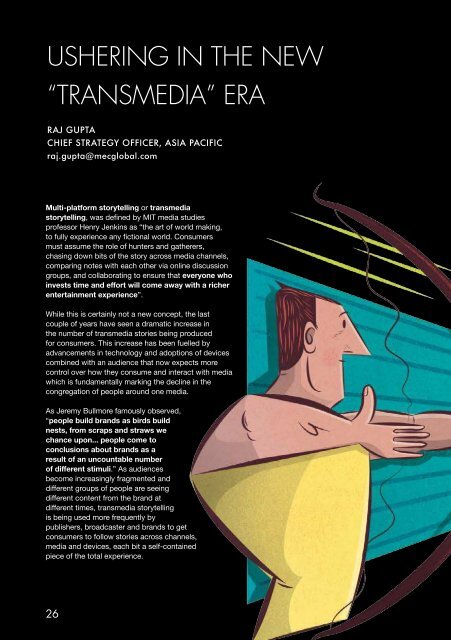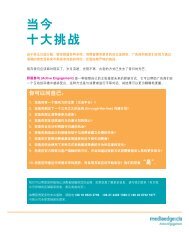IntroductIon - MEC
IntroductIon - MEC
IntroductIon - MEC
Create successful ePaper yourself
Turn your PDF publications into a flip-book with our unique Google optimized e-Paper software.
usherIng In the new<br />
“trAnsmedIA” erA<br />
raJ GuPta<br />
cHief StrateGy officer, aSia Pacific<br />
raj.gupta@mecglobal.com<br />
Multi-platform storytelling or transmedia<br />
storytelling, was defined by MIT media studies<br />
professor Henry Jenkins as “the art of world making,<br />
to fully experience any fictional world. Consumers<br />
must assume the role of hunters and gatherers,<br />
chasing down bits of the story across media channels,<br />
comparing notes with each other via online discussion<br />
groups, and collaborating to ensure that everyone who<br />
invests time and effort will come away with a richer<br />
entertainment experience”.<br />
While this is certainly not a new concept, the last<br />
couple of years have seen a dramatic increase in<br />
the number of transmedia stories being produced<br />
for consumers. This increase has been fuelled by<br />
advancements in technology and adoptions of devices<br />
combined with an audience that now expects more<br />
control over how they consume and interact with media<br />
which is fundamentally marking the decline in the<br />
congregation of people around one media.<br />
As Jeremy Bullmore famously observed,<br />
“people build brands as birds build<br />
nests, from scraps and straws we<br />
chance upon... people come to<br />
conclusions about brands as a<br />
result of an uncountable number<br />
of different stimuli.” As audiences<br />
become increasingly fragmented and<br />
different groups of people are seeing<br />
different content from the brand at<br />
different times, transmedia storytelling<br />
is being used more frequently by<br />
publishers, broadcaster and brands to get<br />
consumers to follow stories across channels,<br />
media and devices, each bit a self-contained<br />
piece of the total experience.<br />
Since the success of BMW’s 2001 campaign,<br />
The Hire, many more marketers have been going<br />
beyond simply telling viewers about the brand<br />
to make it a larger more engaging story. This is<br />
evidenced in the most awarded advertising<br />
campaigns of 2011 (Bing + Jay-Z: Decoded,<br />
Nike Write the Future and Old Spice) all of<br />
which used successfully engaged consumers<br />
with transmedia storytelling.<br />
And, of course, publishers and programme<br />
makers looking for deeper engagement with<br />
their content (and therefore great loyalty and<br />
time spent) have not been slow to this trend<br />
either. NBC Universal (amongst others) is<br />
beginning to develop transmedia storytelling<br />
for their new shows, continuing in 2012 with<br />
a partnership between their SyFy network and<br />
games developer Trion creating a prime-time<br />
weekly TV show Defiance, which incorporates an<br />
MMORPG that will influence the plot and action.<br />
“Transmedia storytelling transforms<br />
communications so that we can interact,<br />
construct, share, and create meaning within<br />
the storyteller’s world. It will be the dominant<br />
form of communication strategy in marketing,<br />
management, entertainment, and education,<br />
because it creates a multi-sensory, immersive<br />
experience directed by the audience.”<br />
Dr. Pamela Rutledge, Director, Media Psychology<br />
Research Center<br />
26 27




